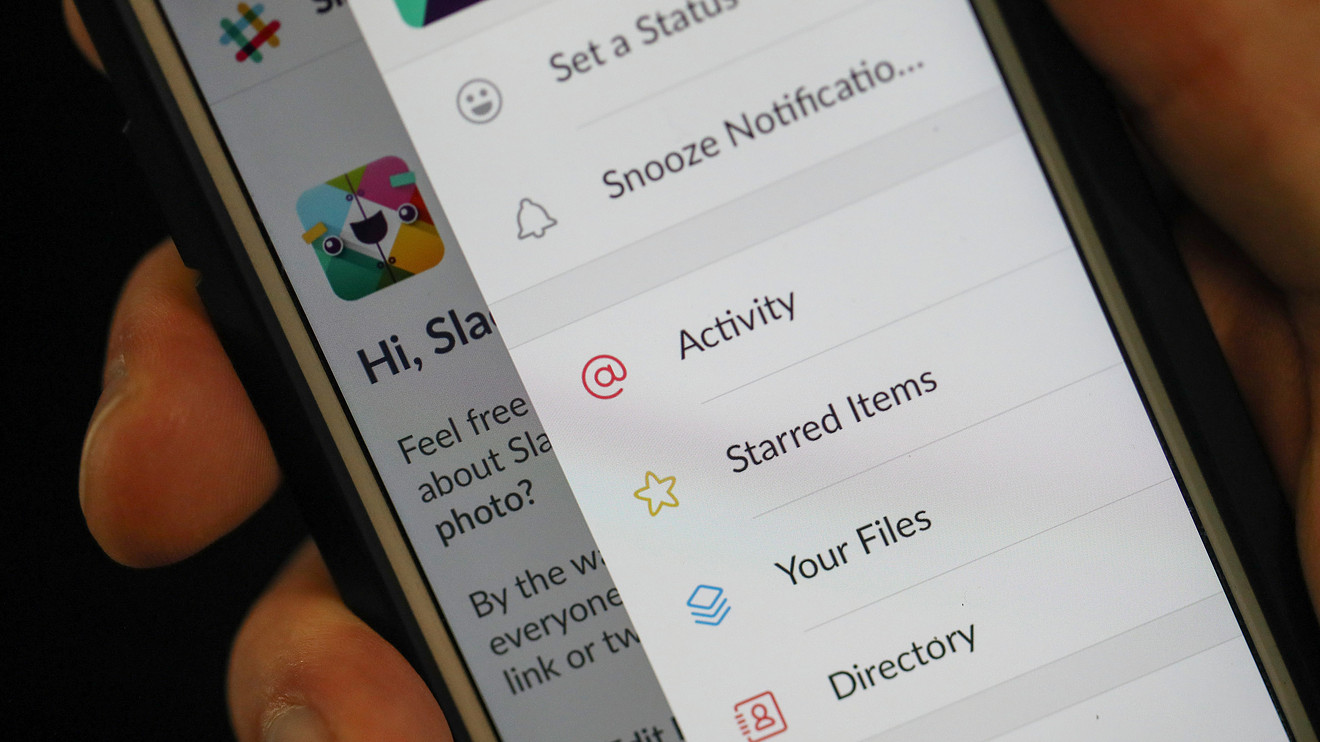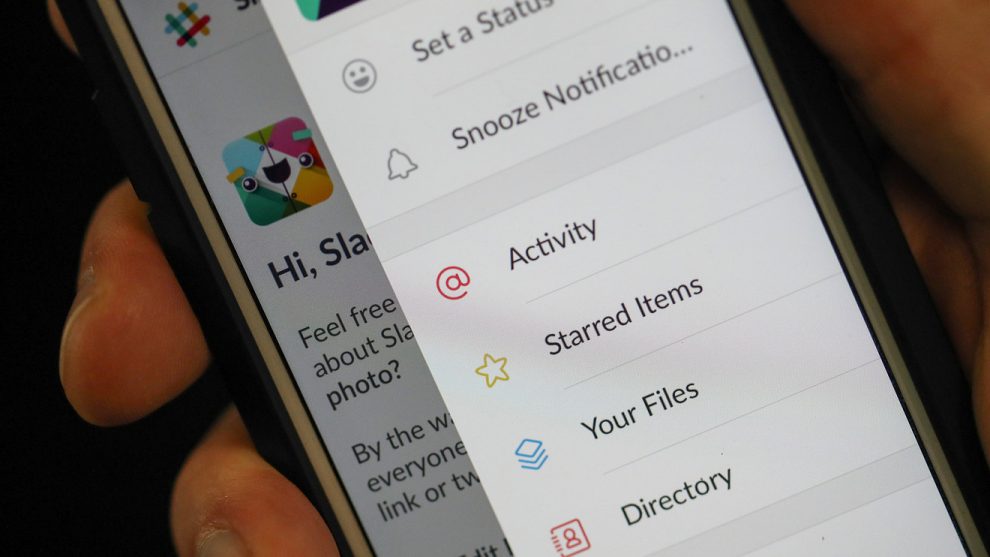
Slack Technologies Inc. is looking for a better direct-listing fate than Spotify Technology SA.
The music-streaming service reminded tech unicorns late last year that companies don’t have to issue new shares or raise money through a traditional offering if they wish to go public, and now Slack is following in its footsteps. The business-chat company is going public through a direct listing. and its shares are expected to start trading Thursday. Late Wednesday, Slack set its reference price at $26 a share, through they are expected to open significantly higher than that.
Direct listings differ from traditional initial public offerings, in that the company doesn’t issue new shares or seek to raise money through the process of going public. Rather, the listing makes it possible for existing shareholders to sell their shares to the public. After Spotify’s direct listing, many said the approach could be used by other startups, given the lack of share dilution and required lockup restrictions.
But Spotify’s stock SPOT, +1.56% hasn’t exactly been well received since the company made its public debut, with shares up only 4% from their reference price at the time of the offering, and down 17% from their opening price. Meanwhile, the S&P 500 index SPX, +0.30% has gained 10% since Spotify went public.
Slack WORK, +0.00% will be hoping its shares are better liked on Wall Street, though the company likely won’t undergo a traditional roadshow through which it can explain its financials to banks and investors in the way companies going the standard IPO route do. Slack recently updated its S-1 with the Securities and Exchange Commission to register nearly 117 million shares and changed the stock ticker it plans to use for trading on the New York Stock Exchange to “WORK” from “SK” as it had stated in its previous S-1.
Slack’s filing reveals a business with slowing revenue growth but narrowing losses, as well as a heavy dependence on just a several hundred key customers, or less than 1% of its paid customer base, for a major chunk of its sales. Here are five things to know about the company:
Revenue deceleration
Slack topped $400 million in annual revenue for its fiscal year ended in January, though growth slowed from the prior period. The company’s revenue rose 82% from $220.5 million in 2018, down from a growth rate of just over 100% a year earlier.
For the first quarter ended in April, Slack generated $134.8 million in revenue, according to a Monday filing, up 67% from a year before.
Founded in 2009, Slack admitted in its prospectus that it has “limited experience with respect to determining the optimal prices for Slack.” The company expects that it might need to change its pricing model periodically going forward.
The messaging company made progress in narrowing its losses, posting a net loss of $140.7 million last year, compared with $181 million a year earlier. Slack continues to see sizable investments in its future, as it grows its sales force and customer experience teams and ramps up marketing spending.
For its second quarter, which ends in July, Slack projects $139 million to $141 million in total revenue and an adjusted loss per share of 19 cents to 20 cents.
Uber IPO: 5 things you need to know about potentially the biggest IPO in years
Heavily reliant on big customers
Slack had more than 95,000 paying customers as of the end of January, but only a small fraction of those accounted for a huge chunk of the company’s revenue.
The latest filing disclosed that Slack has 645 customers—about 0.7% of total paid customers—that each generate more than $100,000 in annual recurring revenue.
The over-$100,000 cohort contributed to about 40% of Slack’s revenue last year, the company said. Slack finds the metric indicative of its ability to attract large businesses to its platform, and the company bills its customers based on the number of users that it has on its platform.
On the opposite end, Slack has a huge base of organizations using the service for free, numbering more than 500,000 at the end of January. “This model facilitates rapid and efficient user adoption, particularly by empowering users to access Slack without the friction of payment or a formal sales interaction,” the prospectus said. “We believe free usage helps prospective paid customers realize the value of Slack and users spread the word organically throughout their networks and organizations.”
Working hard or hardly working
Slack depends on becoming a bigger part of workplace culture so that more users within a given company start to make use of the platform—and pay for it.
The company said that it had 10 million daily active users across its free and paid tiers in the three months ended in January, though it didn’t provide a breakdown between the two. Slack disclosed that “many” of its paid customers have thousands of active users, while the company’s largest paid customers have “tens of thousands” of daily users.
During the final week of January, Slack saw its free and paid user base spend more than 50 million hours combined on the service, sending more than a billion messages. On a normal workday in that period, the company said, users on paid subscriptions were connected to Slack for an average of nine hours and spent more than 90 minutes actively engaging on the service.
Stampede of the ‘decacorns’: Here are the big-name startups preparing for 2019 IPOs
Competing with giants
Uber Technologies Inc. UBER, +2.28% and Lyft Inc. LYFT, -1.32% both debuted lofty mission statements in their IPO filings, promising to “ignite opportunity” through mobility, but Slack played things in a more straightforward fashion. “Our mission is to make people’s working lives simpler, more pleasant, and more productive,” the company said in its prospectus.
Slack acknowledged that it’s going up against at least one big player as it moves to simplify communications at work. The company mentions Microsoft Corp. MSFT, +0.39% as its “primary competitor” currently but admitted that current partners, including Atlassian Corp. PLC TEAM, +2.49% Alphabet Inc.’s Google GOOGL, -0.07% and newly public Zoom Video Communications Inc. ZM, +2.76% could come out with new products to rival Slack’s platform.
“Some of our larger competitors have substantially broader product offerings and leverage their relationships based on other products or incorporate functionality into existing products to gain business in a manner that discourages users from purchasing Slack, including through selling at zero or negative margins, product bundling, or closed technology platforms,” Slack said in its filing.
Another dual-class structure
Slack, like many other hot young tech companies, will have a dual-class stock structure that concentrates voting power among executives and others who owned shares ahead of Slack’s expected listing. The company will list Class A shares on the NYSE, but its Class B shares will each have 10 times the voting power of each Class A share.






